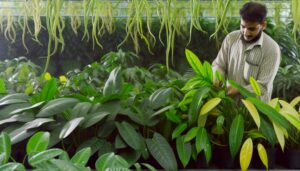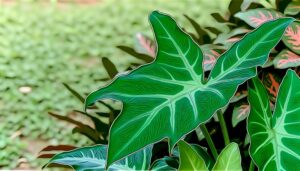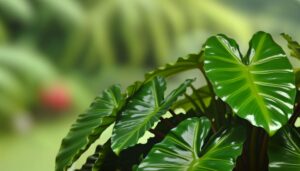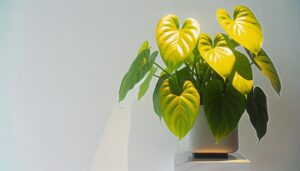What Does a Juvenile Philodendron Melanochrysum Look Like?
A juvenile *Philodendron melanochrysum* exhibits elongated, heart-shaped leaves with an acuminate apex and a wide, cordate base. The leaves are a deep green color with pronounced pale yellow to whitish venation, creating a contrast that highlights the reticulate venation pattern.
The adaxial surface of the leaves has a velvety texture due to trichomes, contributing to a soft, tactile feel. This plant demonstrates a climbing growth habit, supported by aerial roots and elongating internodes.
Juvenile leaves typically lack lobing or serration, maintaining a smooth edge. To explore further details on its unique characteristics, continue following the outlined specifics.
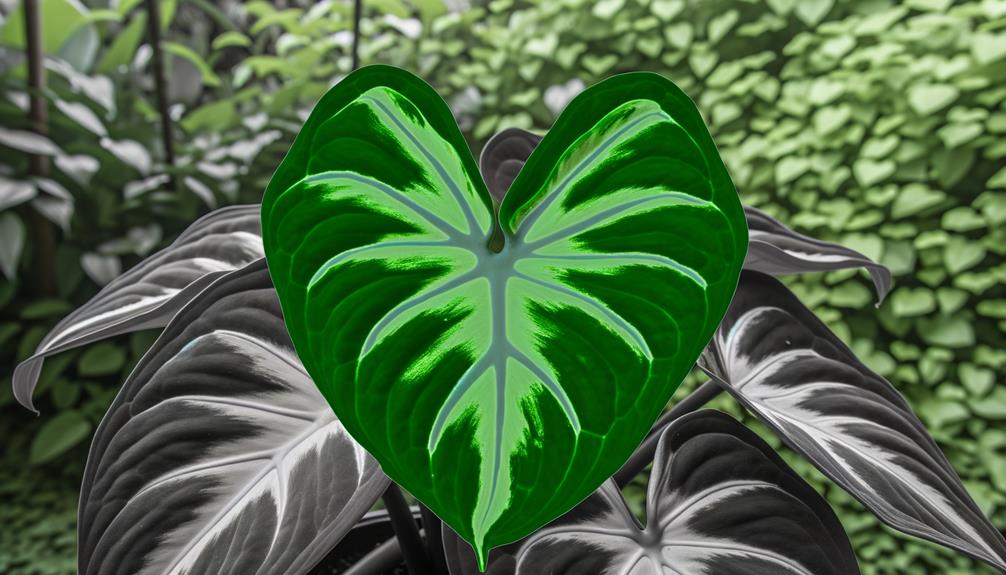
Key Takeaways
- Juvenile Philodendron melanochrysum leaves are elongated, heart-shaped, and have a smooth, whole edge.
- The leaves feature a deep green color with pronounced pale yellow to whitish veins.
- The texture of the leaves is velvety due to trichomes on the adaxial surface.
- The plant exhibits a climbing growth habit with elongated internodes and aerial roots.
- Juvenile leaves have an acuminate apex and a wide, cordate base for effective light absorption.
Leaf Shape and Size
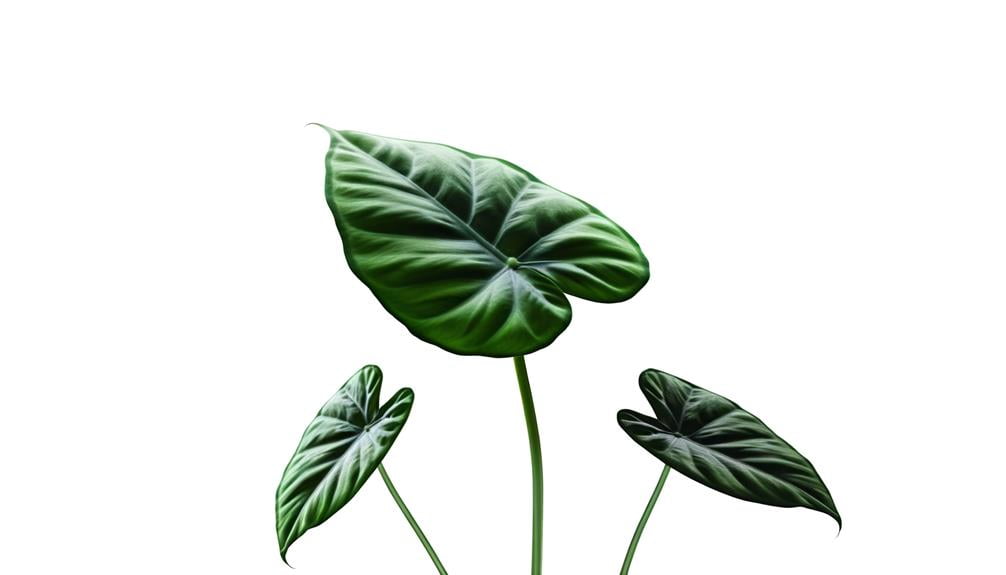
The leaves of the juvenile Philodendron melanochrysum display an elongated, heart-shaped form, typically reaching lengths of up to 20 centimeters in their early stages. These leaves show a distinctive acuminate apex, which tapers to a fine point, and a wide, cordate base that enhances their unique shape.
The petioles, or leaf stalks, are slim and elongate, supporting the leaf blade effectively to maximize light absorption. As the plant matures, the leaf size gradually increases, adapting to its climbing habit. The edges of the leaves are whole, lacking any form of lobing or serration, which contributes to their smooth and uniform appearance.
This specific leaf shape and size are crucial for the ideal physiological functions of the Philodendron melanochrysum.
Color and Veining
In addition to their distinctive shape and size, juvenile Philodendron melanochrysum leaves exhibit a mesmerizing color palette, featuring a deep green hue with pronounced, pale yellow to whitish veining.
The primary lamina of the leaf, Philodendron melanochrysum, is characterized by a rich, verdant green, which provides a striking contrast to the intricate venation. The veins, or reticulate venation pattern, appear prominently against the darker background, creating an almost luminescent effect.
This contrast is a result of the chlorophyll concentration in the mesophyll cells and the reflective properties of the vein's xylem and phloem tissues. The coloration and veining not only contribute to the plant's aesthetic appeal but also play essential roles in photosynthesis and nutrient transport within the leaf structure.
Texture and Feel
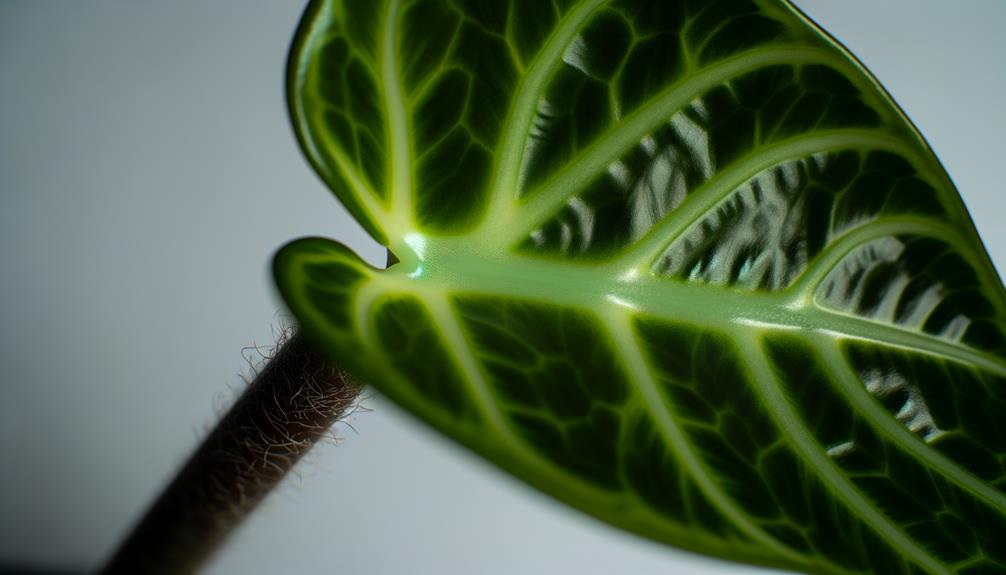
Upon thorough examination, juvenile Philodendron melanochrysum leaves display a velvety texture, credited to the presence of trichomes on the epidermal surface. These trichomes, or fine hair-like structures, impart a soft and tactile feel to the foliage, enhancing its ornamental appeal.
The adaxial (upper) surface showcases a more pronounced velveteen quality in contrast to the abaxial (lower) surface, which tends to be smoother. This textural characteristic is crucial for identifying juvenile specimens, as it differs from the matured leaves that develop a more leathery consistency.
Additionally, the trichomes may play a role in minimizing water loss through transpiration by reducing the leaf's exposure to direct sunlight, thereby adapting the plant to its native humid, understory environment.
Growth Patterns
Juvenile Philodendron melanochrysum exhibits a climbing growth habit facilitated by its aerial roots and internodal elongation. These attributes enable P. melanochrysum to ascend vertical supports, mimicking its natural epiphytic behavior in tropical rainforests.
The internodes, or spaces between leaf nodes, elongate as the plant matures, contributing to its vine-like appearance. Aerial roots emerge from nodes, aiding in nutrient absorption and structural support.
Juvenile leaves are heart-shaped, with a velvety texture, and display a deep green coloration with prominent, light-green veining. As the plant matures, the leaves progressively enlarge, and the vein pattern becomes more pronounced.
This climbing growth pattern is essential for maximizing light exposure and optimizing photosynthetic efficiency in dense forest canopies.
Care Requirements
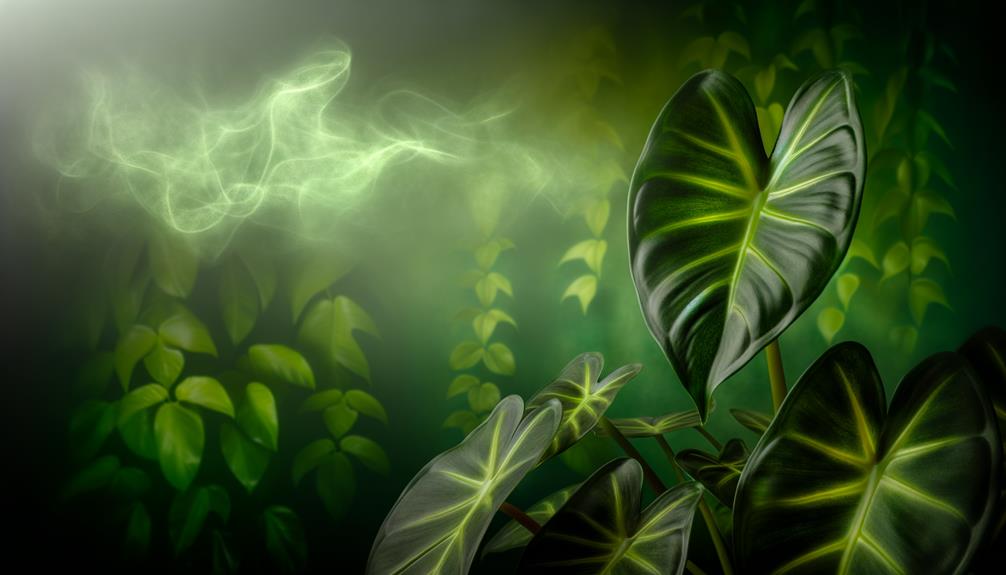
Proper care for Philodendron melanochrysum necessitates maintaining specific environmental conditions, including ideal humidity, temperature, and light levels. Peak humidity should be sustained between 60% to 80%, facilitated by misting or using a humidifier.
The preferred temperature range is 18°C to 27°C, avoiding sudden fluctuations to prevent stress. Light requirements include bright, indirect sunlight; direct exposure might cause leaf scorch.
Utilize well-draining, aerated soil comprising equal parts of peat, perlite, and orchid bark to ensure prime root health. Watering should be thorough but infrequent, allowing the soil to dry slightly between waterings to prevent root rot.
Nutrient supplementation via a balanced, water-soluble fertilizer diluted to half strength, applied monthly during the growing season, enhances vigour and foliage development.
Conclusion
The juvenile Philodendron melanochrysum presents a fascinating botanical study. Its oblong leaves, initially small, exhibit a striking deep green hue with pronounced, silvery-white veining, while the texture is velvety to the touch.
As it matures, the leaf size enlarges, revealing an intricate network of veins. Growth patterns indicate a propensity for climbing, requiring specific support structures.
The suspense lies in its care requirements—will one provide the humidity and light conditions essential for this plant's best growth?

